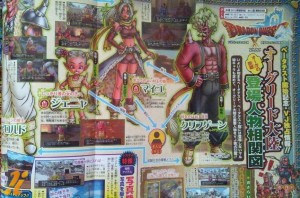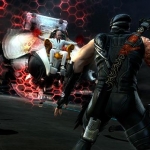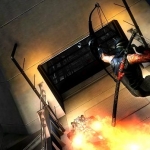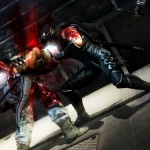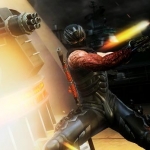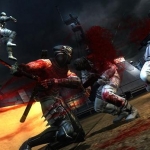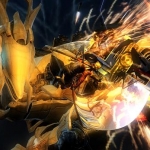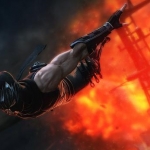Pipeworks Software making unannounced Wii U game
Posted on 13 years ago by Brian(@NE_Brian) in News, Wii U | 0 comments
Pipeworks Software is in possession of Wii U development kits and are currently creating a new title for the console.
Game designer Jess Kappeler wrote the following on his LinkedIn profile:
“During my time at Pipeworks I have shipped five games as a lead designer and four as a game designer across multiple platforms, including PC, Xbox 360, XBLA, PSN and Wii. I am currently working on an unannounced game for Nintendo’s Wii U console.”
Pipeworks Software’s previous games include Zumba Fitness and uDraw Studio.
Is Nintendo Power teasing an Epic Mickey 2 reveal?
Posted on 13 years ago by Brian(@NE_Brian) in Rumors, Wii, Wii U | 0 comments
Although Disney hasn’t confirmed it, numerous pieces of evidence suggest that Epic Mickey 2 is in development. If the speculation is to be believed, Junction Point is preparing the game for the Wii (and possibly Wii U), PlayStation 3, and Xbox 360.
We might be hearing something official about the game next month. The latest Nintendo Power is making the rounds, and the magazine’s teaser page for their April issue says the following:
“There will be no fooling around when it comes to our April issue. We’ll have the final word of Kid Icarus: Uprising and Xenoblade Chronicles in our full reviews, and get an exclusive whiff of a top-secret title that promises to make your head spin.”
In reference to the “top-secret title”, Nintendo Power included a pair of ears that are apparently very reminiscent of Oswald the Lucky Rabbit.
We don’t have an image of the teaser page yet, but we’ll add it into this post once we get our hands on a photo.
Rumor: Nintendo looking into digital distribution partners for Wii U
Posted on 13 years ago by Brian(@NE_Brian) in Rumors, Wii U | 0 comments
Rumor has it that Nintendo is looking into forming ties with a variety of partners for digital distribution on Wii U. In doing so, it would appear that the company has interest in making the console a media entertainment device that goes far beyond what we saw on Wii – it’d be more like what Microsoft is offering with the Xbox 360.
Adweek claims that the company held discussions with “a select number of top content companies” at CES last month “including multiple cable networks and Web video producers”. Sports, music, television, and other entertainment content would be involved in these plans.
One of Adweek’s sources says that “This is very preliminary. It could go nowhere.”
Meanwhile, Wedbush analyst Michael Pachter has already weighed in on the rumor:
“I don’t know if they have the chops to pull it off. I don’t think game publishers are going to support it (the console).”
Rumor: 5th Cell creating Wii U launch title
Posted on 13 years ago by Brian(@NE_Brian) in News, Wii U | 0 comments
As far as we know, David Franco is a freelancer in the video game industry. Having said that, it seems that all of his previous work has been for 5th Cell, the developer behind the Scribblenauts and Drawn to Life titles.
So why is this information useful? Well, it looks like 5th Cell might be making a launch title for Wii U.
Franco listed the following games as projects he’s worked on in the past:
LATEST TITLES:
Drawn to Life, Drawn to Life: The Next Chapter, Lock’s Quest, Scribblenauts, Super Scribblenauts, Hybrid, Unannounced Wii U launch title.
Given Franco’s history with 5th Cell, one would think that the mysterious “Unannounced Wii U launch title” is being made by the studio.
Sakurai starting to think about next Smash Bros. games
Posted on 13 years ago by Brian(@NE_Brian) in 3DS, General Nintendo, News, Wii U | 0 comments
Kid Icarus: Uprising development is finished, and the game will soon be out around the world. Director Masahiro Sakurai won’t have much time to rest, as he’ll be responsible for the next round of highly anticipated Super Smash Bros. titles.
Sakurai seems to be doing some reflection. On Twitter earlier today, Sakurai said that he’s been looking over the Smash Bros. Dojo website, which was used to communicate news about Super Smash Bros. Brawl to fans. He said, “However, what’s the word… it’s tremendous. How did we make this?”
Indies Zero CEO Masanobu Suzui saw Sakurai’s message and said something similar. Once a game is done and he check outs the design documents, materials, and development schedule for a project, he isn’t sure how the team managed to put everything together and create the title.
Sakurai’s response? “It’s because we always put our full effort into it. And then, if you rely on that pace, it becomes more and more difficult.”
Famitsu’s most-wanted games – issue 1211
Posted on 13 years ago by Brian(@NE_Brian) in 3DS, News, Wii, Wii U | 0 comments
01/02. [PS3] Dragon’s Dogma (Capcom) – 790 votes
02/01. [Wii] Dragon Quest X: Rise of the Five Tribes Online (Square Enix) – 644 votes
03/04. [PS3] One Piece: Kaizoku Musou (Namco Bandai) – 566 votes
04/05. [3DS] Monster Hunter 4 (Capcom) – 562 votes
05/03. [PSV] Persona 4: The Golden (Atlus) – 537 votes
06/07. [PS3] Resident Evil 6 (Capcom) – 405 votes
07/08. [PSP] Shining Blade (Sega) – 376 votes
08/11. [PSP] 2nd Super Robot Wars Z Hakai Volume (Namco Bandai) – 312 votes
09/23. [PS3] Resident Evil: Operation Raccoon City (Capcom) – 307 votes
10/16. [PS3] Asura’s Wrath (Capcom) – 277 votes
11/12. [PS3] Final Fantasy Versus XIII (Square Enix) – 307 votes
12/09. [3DS] Animal Crossing 3DS (Nintendo) – 251 votes
13/06. [3DS] Kingdom Hearts 3D: Dream Drop Distance (Square Enix) – 246 votes
14/28. [3DS] Fire Emblem: Awakening (Nintendo) – 223 votes
15/24. [3DS] Kid Icarus: Uprising (Nintendo) – 208 votes
16/14. [PS3] Metal Gear Rising: Revengeance (Konami) – 206 votes
17/17. [PS3] 2nd Super Robot Wars OG (Namco Bandai) – 201 votes
18/30. [PSP] God Eater 2 (Namco Bandai) – 177 votes
19/18. [PS3] The Last Remnant (Square Enix) – 171 votes
20/21. [3DS] Dragon Quest Monsters: Terry’s Wonderland 3D (Square Enix) – 168 votes
21/22. [PSP] Yakuza: Black Panther 2 (Sega) – 164 votes
22/23. [3DS] Fantasy Life (Level-5) – 154 votes
23/20. [PS3] The Last Guardian (SCEJ) – 153 votes
24/27. [3DS] Hatsune Miku & Future Stars: Project Mirai (Sega) – 148 votes
25/19. [PS3] Toki to Towa (Namco Bandai) – 136 votes
26/26. [PS3] Persona 4: The Ultimate in Mayonaka Arena (Atlus) – 123 votes
27/29. [PS3] The Witch and the Hundred Soldiers (NIS) – 115 votes
28/—. [PSP] Tales of the Heroes: Twin Brave (Namco Bandai) – 111 votes
29/—. [PSP] Nenodroid Generation (Namco Bandai) – 87 votes
30/—. [PS3] Street Fighter X Tekken (Capcom) – 84 votes
New Ninja Gaiden III screenshots
Posted on 13 years ago by Brian(@NE_Brian) in Screenshots, Wii U | 0 comments
New Ninja Gaiden III trailer
Posted on 13 years ago by Brian(@NE_Brian) in Videos, Wii U | 0 comments
2011 Wii U patent points to likely canned features: 3D, HD display
Posted on 13 years ago by Brian(@NE_Brian) in News, Wii U | 0 comments
A September 2011 patent filed by Nintendo may provide some insight as to what sort of features the company was considering for the Wii U.
Much of the interesting tidbits pertain to the console’s controller. It seems that Nintendo has been experimenting with 3D and an HD display for the console’s innovative controller.
A quick rundown of the patent’s more noteworthy details can be found below.
– Could come with voice recognition software
– Players could give voice commands in-game
– “one or more additional microphones…may be provided on the front and/or back surfaces” of the controller
– Controller’s camera could recognize a face/parts of a person’s face
– This face data could be stored in Wii U’s main memory
– Wii U could be used as a videophone “exchanging images and sound”
– Hints that Skype/Skype-like service was being considered for Wii U; may still be possible
– Peripheral attachment examples: “a game-specific controller (gun-shaped controller, etc.) or an input device such as a keyboard”
– Wii U “might” feature a 3D display
– Wii U controller “might” feature an HD display (controller is sub-HD resolution of 850x or so)
Thanks to Captain N for the tip!
